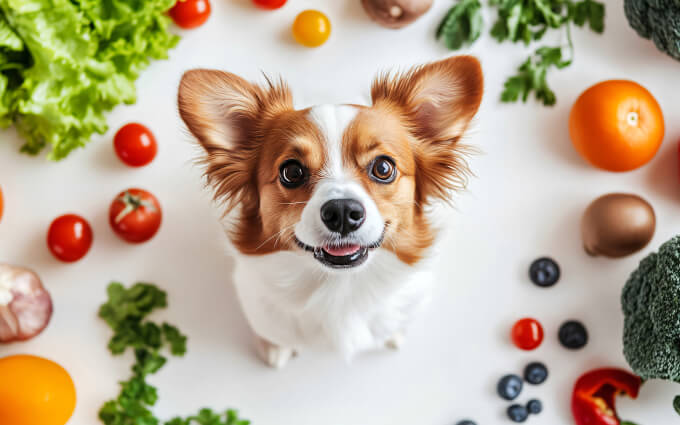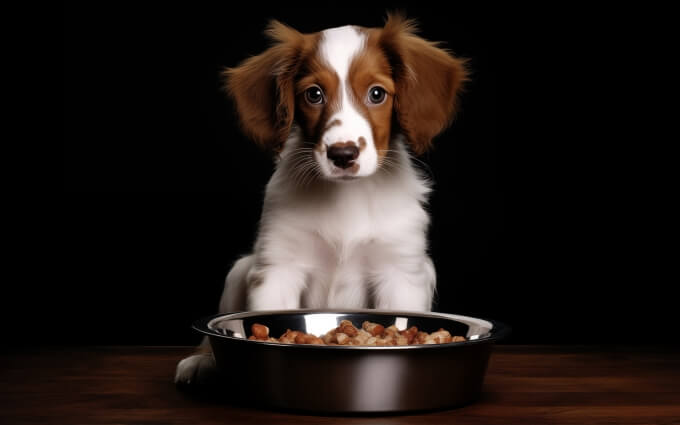- Home
- Food & Nutrition
- Wet vs Dry Dog Food - What's the Better Choice?
Wet vs Dry Dog Food - What's the Better Choice?
Deciding between wet and dry dog food involves considering various factors like your dog's health, preferences, and your lifestyle. This guide covers the pros and cons of both to help you make an informed choice.

- 28

Understanding Wet Dog Food
Wet dog food, also known as canned food, is beloved by many pups for its rich aroma and flavor. This type of food is typically higher in moisture content, often reaching up to 78%. This can be particularly beneficial for dogs that don't drink enough water or have certain health conditions requiring increased hydration.
Pros of Wet Dog Food
- High moisture content aids hydration
- Soft texture is easier for dogs with dental issues
- Rich flavor and aroma can entice picky eaters
Cons of Wet Dog Food
- More expensive than dry food
- Shorter shelf life once opened
- Can contribute to dental issues due to lack of chewing
The Lowdown on Dry Dog Food
Dry dog food, or kibble, is a convenient and cost-effective option. It has a longer shelf life and is easier to store and portion. Dry food also plays a role in maintaining your dog's dental health, as the chewing action can help reduce tartar buildup.
Pros of Dry Dog Food
- More economical and easier to store
- Contributes to dental health through chewing
- Can be left out without spoiling
Cons of Dry Dog Food
- Lower moisture content requires constant access to water
- May not be as palatable as wet food
- Potential inclusion of fillers and grains
Nutritional Comparison
Both wet and dry dog foods are formulated to meet the nutritional standards set by the Association of American Feed Control Officials (AAFCO). However, they differ in nutrient density and content due to their physical forms. Wet dog food typically has a higher concentration of proteins and fats, making it suitable for active dogs and those needing higher energy intake. On the other hand, dry dog food usually contains more carbohydrates and fiber, supporting sustained energy and digestive health.
Key Nutritional Points
- Wet food is often richer in protein and fat
- Dry food contains more carbohydrates and dietary fibers
- Both types can be nutritionally complete and balanced
Special Considerations
Your dog's specific needs and health conditions play a significant role in choosing the right food. For example, dogs with kidney or urinary issues might benefit from the hydration offered by wet food. Meanwhile, dogs with strong, healthy teeth might thrive on dry kibble that helps keep their teeth clean. Additionally, mixing both wet and dry food can provide a balanced approach, combining the benefits of both types.
Consult with Your Veterinarian
It's always best to discuss your dog's diet with your veterinarian. They can provide personalized recommendations based on your dog's age, breed, activity level, and health status, ensuring that your furry friend receives the optimal nutrition they need.
Making the Final Decision
Ultimately, the choice between wet and dry dog food depends on various factors, including your dog's health needs, preferences, and your own convenience and budget considerations. Some dogs may prefer the taste and texture of wet food, while others might benefit more from the dental advantages and cost-effectiveness of dry food.
Key Takeaways
- Consider your dog's hydration needs, dental health, and flavor preferences
- Evaluate the cost and convenience of each type of food
- Consult your veterinarian for tailored advice
Whether you choose wet food, dry food, or a combination of both, the most important thing is to ensure that your dog's diet is nutritious, balanced, and suited to their unique needs.
Frequently Asked Questions about Wet vs Dry Dog Food
Is wet or dry dog food better for my dog?
Both have benefits - dry food is convenient and good for dental health, while wet food is tastier and provides more hydration.
What are the advantages of dry dog food?
Dry food is easy to store, usually more affordable, and helps reduce plaque and tartar buildup.
What are the benefits of wet dog food?
Wet food has higher moisture content, making it ideal for picky eaters, older dogs, or those needing extra hydration.
Can I mix wet and dry dog food?
Yes, mixing both can provide balanced nutrition, variety, and the benefits of each type.
Which is healthier, wet or dry dog food?
Both can be healthy if they are high-quality; the best choice depends on your dog's age, health, and preferences.
- 28
 Marcin Solgaard
Marcin Solgaard
Marcin is a true dog enthusiast! He is always seen with his 9-year-old boxer by his side. Marcin believes that dogs thrive on love, fun and positive experiences. On their daily adventures, people often stop Marcin to ask how his boxer is so happy and well-behaved. He happily shares tips on dog behavior and fun activities to create a happy and harmonious life with your dog.
-
Food & Nutrition
 The Best Foods to Boost Your Dog's Immune System
The Best Foods to Boost Your Dog's Immune SystemTo keep your dog healthy and resilient, fueling their immune system with the right foods is key. In this post, we'll cover the top nutrient-packed foods that can give your dog's immune system the support it needs, helping them fend off illness and stay energetic.
 Marcin SolgaardOct 04, 20249
Marcin SolgaardOct 04, 20249 -
Food & Nutrition
 Is Your Dog a Picky Eater? Here's How to Get Them to Eat!
Is Your Dog a Picky Eater? Here's How to Get Them to Eat!Struggling with a picky dog? Explore these methods to make mealtime enjoyable for even the fussiest pups, ensuring they get the nutrition they need.
 Marcin SolgaardMay 30, 202435
Marcin SolgaardMay 30, 202435 -
Dog health
 Which Emotions Do Dogs Actually Experience? Understanding Your Dog's Emotions
Which Emotions Do Dogs Actually Experience? Understanding Your Dog's EmotionsDogs experience a variety of basic emotions similar to those of a young child. Learn about the emotions your dog truly feels, how they express them, and what it means for your relationship.
 Cassandra DalgaardJul 30, 202478
Cassandra DalgaardJul 30, 202478 -
Dog health
 Essential Tips for Caring for Your Dog's Teeth and Gums
Essential Tips for Caring for Your Dog's Teeth and GumsMaintaining your dog's dental health is crucial for their overall well-being. This guide covers various methods to care for your dog's teeth and gums, ensuring they stay healthy and happy.
 Cassandra DalgaardAug 19, 202436
Cassandra DalgaardAug 19, 202436 -
Food & Nutrition
 Dog Supplements: When and Why to Use Them
Dog Supplements: When and Why to Use ThemDog supplements can enhance your furry friend's health by filling nutritional gaps and addressing specific health issues. Learn when and why to use them.
 Michelle TorringAug 28, 202432
Michelle TorringAug 28, 202432 -
Food & Nutrition
 How to Choose the Right Diet for Your Allergic Dog
How to Choose the Right Diet for Your Allergic DogFind out how to select the perfect diet for your dog with allergies. Learn about elimination diets, hypoallergenic foods, and the best ingredients to keep your furry friend healthy and happy.
 Marcin SolgaardJun 09, 202427
Marcin SolgaardJun 09, 202427 -
Dog Behavior
 Does My Dog Know I Care About It?
Does My Dog Know I Care About It?Discover the ways your dog shows it knows you care and how you can reinforce that loving bond through simple actions and daily interactions.
 Cassandra DalgaardAug 05, 202444
Cassandra DalgaardAug 05, 202444 -
Dog health
 Are Dogs Really Color Blind? The Truth About Canine Vision
Are Dogs Really Color Blind? The Truth About Canine VisionDiscover how dogs see the world, what colors they can perceive, and the science behind their unique vision. This blog post delves into the myth of dogs being color blind and explains their actual color perception.
 Marcin SolgaardMay 26, 202433
Marcin SolgaardMay 26, 202433 -
Dog Behavior
 How to Help a Shy or Nervous Dog Build Confidence
How to Help a Shy or Nervous Dog Build ConfidenceHelping a shy or nervous dog build confidence takes time, patience, and the right techniques. With a structured approach, you can gradually encourage your dog to feel safe, secure, and ready to take on new challenges.
 Michelle TorringSep 22, 202415
Michelle TorringSep 22, 202415 -
Puppies & Young dogs
 How Many Litters Can a Dog Have? Everything You Need to Know
How Many Litters Can a Dog Have? Everything You Need to KnowLearn about the number of litters a dog can safely have, ethical considerations, health implications, and best breeding practices to ensure the well-being of your dog.
 Michelle TorringAug 01, 202456
Michelle TorringAug 01, 202456










